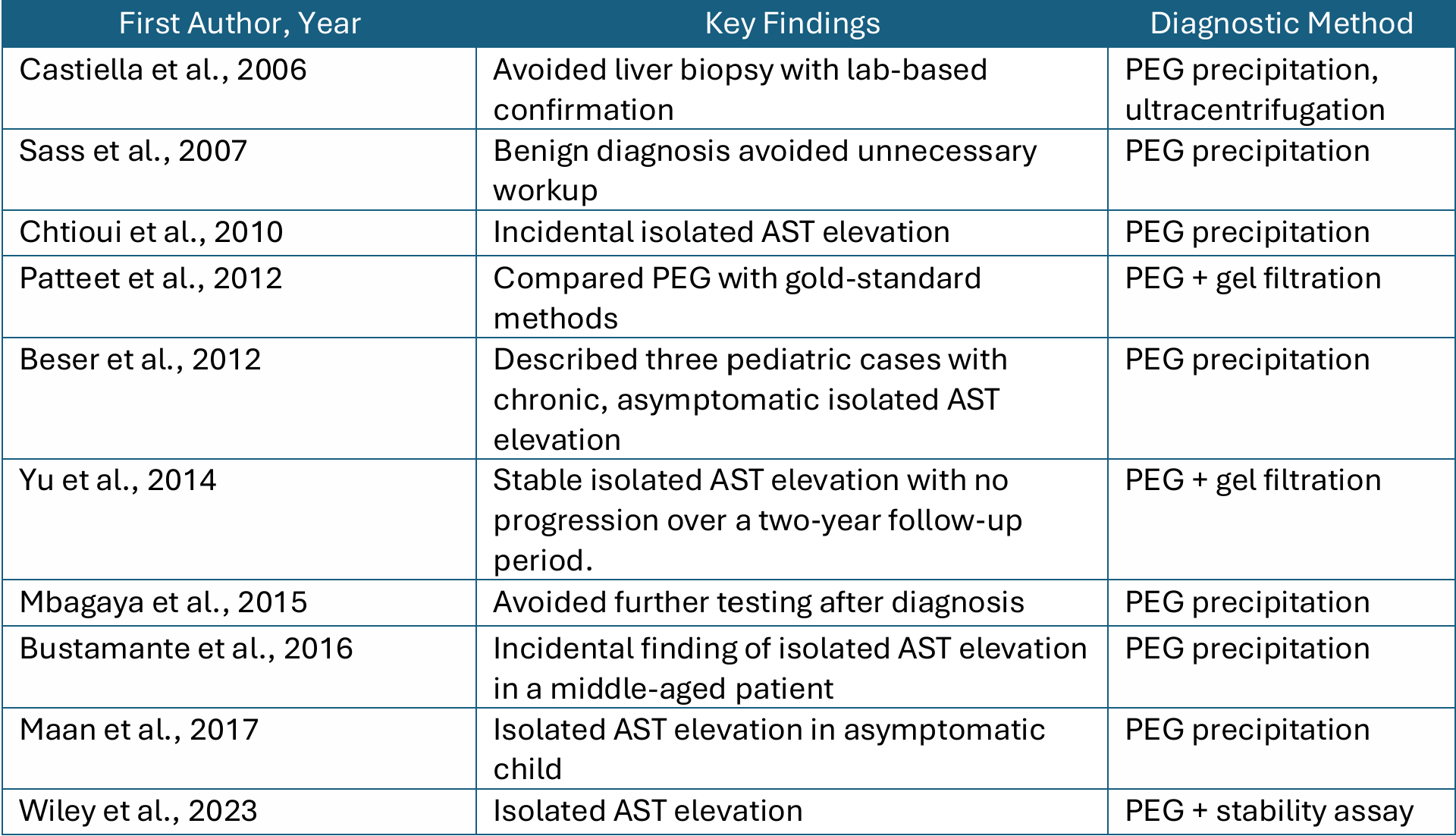Sunday Poster Session
Category: Liver
P1609 - Macro‑AST: A Systematic Review of Reported Cases and Diagnostic Approaches
Sunday, October 26, 2025
3:30 PM - 7:00 PM PDT
Location: Exhibit Hall

Abdullah Sultany, MD
Guthrie Robert Packer Hospital, Department of Internal Medicine
Sayre, PA
Presenting Author(s)
Abdullah Sultany, MD1, Adishwar Rao, MD1, Amlish Gondal, MD1, Abdullah M. Al-Qudah, MD2, Tsu Yang, MD3, Chaitanya K. Chandrala, MD3, Michael Georgetson, MD, FACG3
1Guthrie Robert Packer Hospital, Department of Internal Medicine, Sayre, PA; 2University of Pittsburgh School of Medicine, Department of Neurology, Pittsburgh, PA; 3Guthrie Robert Packer Hospital, Department of Gastroenterology, Sayre, PA
Introduction: Elevated transaminases, especially alanine aminotransferase (ALT) and aspartate aminotransferase (AST), are commonly associated with liver damage, cardiac or renal injury, muscle breakdown, drug or alcohol use, and hemolytic anemia. However, isolated AST elevation in an otherwise asymptomatic patient is rare. One uncommon and benign cause is macro-aspartate aminotransferase (macro-AST), a high-molecular-weight enzyme formed by complexes between AST and immunoglobulins (primarily IgG and IgM) or other plasma components. This results in isolated serum AST elevation without evidence of actual liver or muscle injury. Patients typically remain asymptomatic. Because macro-AST is so rare, it is often overlooked, leading to unnecessary and sometimes invasive investigations, such as liver biopsy, before the diagnosis is made.
Methods: We performed a comprehensive literature search (PubMed, Semantic Scholar, Google Scholar) from database inception through April 2025, using terms such as ‘macro-AST,’ ‘isolated AST elevation,’ and ‘benign AST complex.’ Case reports and series spanning pediatric and adult populations were included.
Results: Our review of published cases highlights key clinical presentation and diagnostic approaches. Several methods are available to detect macro-enzyme complexes, including ultracentrifugation, polyethylene glycol (PEG) precipitation, and gel filtration chromatography. Although gel filtration is the gold standard, its complexity and cost limit routine use. PEG precipitation is the most widely used and cost-effective method despite its lower specificity and the lack of standardized reference values. Results are typically expressed as the reduction in AST; the proportion recovered post-precipitation or the percentage of PEG-precipitable activity (PPA). A PPA cut-off of 73% is commonly used, although some authors propose a range between 67.1% and 82.2%. Values above these thresholds strongly suggest macro-AST.
Discussion: Macro-AST is a rare and benign cause of isolated AST elevation resulting from enzyme-immunoglobulin complexes that persist in circulation without causing tissue injury. Although reported infrequently, macro-AST should be considered in asymptomatic patients with persistent AST elevation and unremarkable workups. Early diagnosis of macro-AST using cost-effective methods, such as PEG precipitation, can prevent unnecessary procedures and reduce healthcare costs. Greater clinician awareness is essential.

Figure: Table 1. Summary of Published Macro-AST Cases and Diagnostic Methods
Disclosures:
Abdullah Sultany indicated no relevant financial relationships.
Adishwar Rao indicated no relevant financial relationships.
Amlish Gondal indicated no relevant financial relationships.
Abdullah M. Al-Qudah indicated no relevant financial relationships.
Tsu Yang indicated no relevant financial relationships.
Chaitanya K. Chandrala indicated no relevant financial relationships.
Michael Georgetson indicated no relevant financial relationships.
Abdullah Sultany, MD1, Adishwar Rao, MD1, Amlish Gondal, MD1, Abdullah M. Al-Qudah, MD2, Tsu Yang, MD3, Chaitanya K. Chandrala, MD3, Michael Georgetson, MD, FACG3. P1609 - Macro‑AST: A Systematic Review of Reported Cases and Diagnostic Approaches, ACG 2025 Annual Scientific Meeting Abstracts. Phoenix, AZ: American College of Gastroenterology.
1Guthrie Robert Packer Hospital, Department of Internal Medicine, Sayre, PA; 2University of Pittsburgh School of Medicine, Department of Neurology, Pittsburgh, PA; 3Guthrie Robert Packer Hospital, Department of Gastroenterology, Sayre, PA
Introduction: Elevated transaminases, especially alanine aminotransferase (ALT) and aspartate aminotransferase (AST), are commonly associated with liver damage, cardiac or renal injury, muscle breakdown, drug or alcohol use, and hemolytic anemia. However, isolated AST elevation in an otherwise asymptomatic patient is rare. One uncommon and benign cause is macro-aspartate aminotransferase (macro-AST), a high-molecular-weight enzyme formed by complexes between AST and immunoglobulins (primarily IgG and IgM) or other plasma components. This results in isolated serum AST elevation without evidence of actual liver or muscle injury. Patients typically remain asymptomatic. Because macro-AST is so rare, it is often overlooked, leading to unnecessary and sometimes invasive investigations, such as liver biopsy, before the diagnosis is made.
Methods: We performed a comprehensive literature search (PubMed, Semantic Scholar, Google Scholar) from database inception through April 2025, using terms such as ‘macro-AST,’ ‘isolated AST elevation,’ and ‘benign AST complex.’ Case reports and series spanning pediatric and adult populations were included.
Results: Our review of published cases highlights key clinical presentation and diagnostic approaches. Several methods are available to detect macro-enzyme complexes, including ultracentrifugation, polyethylene glycol (PEG) precipitation, and gel filtration chromatography. Although gel filtration is the gold standard, its complexity and cost limit routine use. PEG precipitation is the most widely used and cost-effective method despite its lower specificity and the lack of standardized reference values. Results are typically expressed as the reduction in AST; the proportion recovered post-precipitation or the percentage of PEG-precipitable activity (PPA). A PPA cut-off of 73% is commonly used, although some authors propose a range between 67.1% and 82.2%. Values above these thresholds strongly suggest macro-AST.
Discussion: Macro-AST is a rare and benign cause of isolated AST elevation resulting from enzyme-immunoglobulin complexes that persist in circulation without causing tissue injury. Although reported infrequently, macro-AST should be considered in asymptomatic patients with persistent AST elevation and unremarkable workups. Early diagnosis of macro-AST using cost-effective methods, such as PEG precipitation, can prevent unnecessary procedures and reduce healthcare costs. Greater clinician awareness is essential.

Figure: Table 1. Summary of Published Macro-AST Cases and Diagnostic Methods
Disclosures:
Abdullah Sultany indicated no relevant financial relationships.
Adishwar Rao indicated no relevant financial relationships.
Amlish Gondal indicated no relevant financial relationships.
Abdullah M. Al-Qudah indicated no relevant financial relationships.
Tsu Yang indicated no relevant financial relationships.
Chaitanya K. Chandrala indicated no relevant financial relationships.
Michael Georgetson indicated no relevant financial relationships.
Abdullah Sultany, MD1, Adishwar Rao, MD1, Amlish Gondal, MD1, Abdullah M. Al-Qudah, MD2, Tsu Yang, MD3, Chaitanya K. Chandrala, MD3, Michael Georgetson, MD, FACG3. P1609 - Macro‑AST: A Systematic Review of Reported Cases and Diagnostic Approaches, ACG 2025 Annual Scientific Meeting Abstracts. Phoenix, AZ: American College of Gastroenterology.
